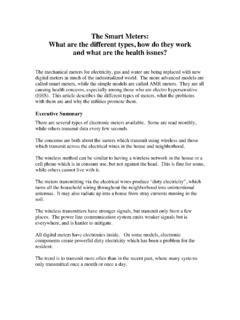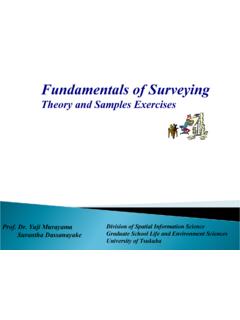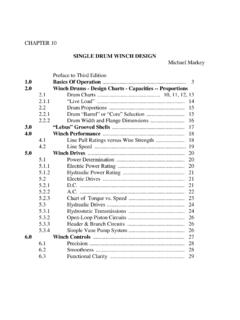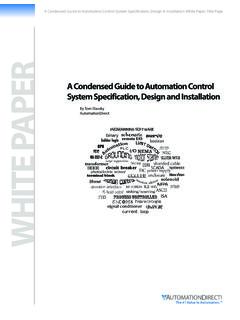Transcription of Fisher i2P-100 Electro‐Pneumatic Transducer
1 i2P-100 electro Pneumatic of Area Classifications and SpecialInstructions for Safe Use and Installationin Hazardous Pressure of Module Module 1. Fisher i2P 100 electro PneumaticTransducerW8710 REPLACEABLEFILTER WITHREMOVABLEORIFICEINTEGRAL PNEUMATICRELAYVENTP arts of ManualThis instruction manual provides installation, operation, maintenance, and parts ordering information for the Fisheri2P 100 Transducer (see figure 1).Refer to separate manuals for instructions covering equipment used with the not install, operate, or maintain an i2P-100 electro pneumatic Transducer without being fully trained and qualifiedin valve, actuator, and accessory installation, operation and maintenance. To avoid personal injury or propertydamage it is important to carefully read, understand, and follow all of the contents of this manual, including all safetycautions and warnings.
2 If you have any questions about these instructions, contact your Emerson sales office or LocalBusiness ManualD103198X012i2P-100 TransducerJuly 2018 Instruction ManualD103198X012i2P-100 TransducerJuly 20182 CAUTIOND ropping or rough handling of the Transducer can cause damage to the converter module resulting in a shifted output or aminimum Transducer receives a 4 20 mA DC input signal and transmits a proportional user field configurable pneumaticoutput pressure to a final control element. The pneumatic output ranges are typically to bar (3 to 15 psig), to bar (6 to 30 psig), and to bar (2 to 33 psi). A typical application is in electronic control loops wherethe final control element is a control valve assembly that is pneumatically operated. The input signal and outputpressure range of the Transducer is indicated on the nameplate, attached to the for the i2P 100 Transducer are listed in table 1.
3 WARNINGThis product is intended for a specific current range, temperature range and other application specifications. Applyingdifferent current, temperature and other service conditions could result in malfunction of the product, property damage orpersonal ServicesFor information on available courses for the i2P 100 electro pneumatic Transducer , as well as a variety of otherproducts, contact:Emerson Automation SolutionsEducational Services - RegistrationPhone: 1-641-754-3771 or 1-800-338-8158E-mail: calculate pneumatic energy savingsScan or clickcode to find outmore about thei2P-100 transducerInstruction ManualD103198X012i2P-100 TransducerJuly 20183 Table 1. SpecificationsInput SignalAvailable as standard with 4 20 configurable by dip switch for split ranging, seetable Signal(1)Available as standard to bar (3 to 15 psig), bar (6 to 30 psig), or to bar (2 to 33 psig).
4 User configurable by dip switchselection and zero and span potentiometeradjustment, see table SignalOutput PressureBarpsig4 20 mA to to to to to to 334 12 mA to to 1512 20 mA to to 15 Equivalent CircuitThe i2P 100 equivalent circuit is a series circuitconsisting of a constant voltage drop (battery) ofapproximately 4 VDC and a total resistance of 40ohms. Input is shunted by two V zener diodes (seefigure 9).Supply Pressure(2)Recommended: bar (5 psi) higher than upperrange limit of output signalMaximum: bar (50 psig)Medium: Air or Non-Corrosive Natural GasMaximum Steady-State Flow RateRefer to tables 3 and 4 Maximum Output Air Capacity(3) m3/hr (300 scfh) at bar (20 psig) supplypressurePerformance(4)Reference Accuracy: of full scale output span.
5 Includes combined effects of hysteresis, linearity, anddeadbandIndependent Linearity: of full scale output spanHysteresis: of full scale output spanFrequency Response: Gain is attenuated 3 dB at 3 Hzwith Transducer output signal piped to a typicalinstrument inputTemperature Effect: per degrees Celsius( per degrees Fahrenheit) of spanSupply Pressure Effect: of full scale output spanper psi supply pressure changeVibration Effect: Less than 1% of full scale output spanwhen tested to ISA CompatibilityMeets EN 61326 1:2013 Immunity Industrial locations per Table 2 of EN 61326 1 Standard. Performance is shown in table 2 below. Emissions Class A ISM equipment rating: Group 1, Class AOperating Ambient Temperature Limits(2)-40 to 85_C (-40 to 185_F)Electrical SealSingle sealed device per ANSI/ISA ClassificationHazardous Area:CSA Intrinsically Safe, Explosion-proof,Type n, Dust Ignition proofFM Intrinsically Safe, Explosion-proof, Type n, Non incendive, Dust Ignition proofATEX Intrinsically Safe, Flameproof, Type nIECEx Intrinsically Safe, Flameproof, Type nElectrical Housing:When Remotely VentedNo Remote VentingCSA Type 4X NEMA 4 XATEX IP66 IECEx IP66 CSA Type 3 NEMA 3 ATEX IP64 IECEx IP64(continued)Instruction ManualD103198X012i2P-100 TransducerJuly 20184 Table 1.
6 Specifications (continued)Other Classifications/CertificationsCUTR Customs Union Technical Regulations (Russia, Kazakhstan, Belarus, and Armenia)INMETRO National Institute of Metrology, Quality,and Technology (Brazil)KGS Korea Gas Safety Corporation (South Korea)NEPSI National Supervision and Inspection Centrefor Explosion Protection and Safety ofInstrumentation (China)Contact your Emerson sales office or Local BusinessPartner for classification/certification specificinformationConnectionsSupply and Output Pressure: 1/4 NPT internalconnectionVent: 1/4 NPT internalElectrical: Standard 1/2 NPTWire Size: 18 to 22 AWGA djustments(1)Zero and Span: Trim potentiometers (20 turn) forzero and span adjustments are located under thehousing cap (see figure 10).Switch: Allows input signal split range anduser configurable to bar (2 to 33 psig) PositionJ Actuator J pipestand or J surfaceApproximate Weight ( Transducer Only) kg ( lbs)Actuator Stroking TimeSee figure 2 Declaration of SEPF isher Controls International LLC declares thisproduct to be in compliance with Article 4 paragraph3 of the PED Directive 2014/68/EU.
7 It was designedand manufactured in accordance with SoundEngineering Practice (SEP) and cannot bear the CEmarking related to PED , the product may bear the CE marking toindicate compliance with other applicable EuropeanCommunity : Specialized instrument terms are defined in ANSI/ISA Standard - Process Instrument Terminology1. For other ranges, zero and span adjustments are The pressure and temperature limits in this document and any applicable standard or code limitation should not be Normal m3/hr Normal cubic meters per hour (0_C and bar, absolute). Scfh Standard cubic feet per hour (60_F and psia).4. Performance values are obtained using a Transducer with a 4 to 20 mA DC input signal and a to bar (3 to 15 psig) output signal at an ambient temperature of 24_C (75_F).
8 Table 2. EMC Summary Results ImmunityPortPhenomenonBasic StandardTest LevelPerformanceCriteria(1)EnclosureElec trostatic discharge (ESD)IEC 61000 4 24kV Contact8kV AirARadiated EM fieldIEC 61000 4 380 to 1000 MHz @ 10V/m with 1 kHz AM at 80%1400 to 2000 MHz @ 3V/m with 1 kHz AM at 80%2000 to 2700 MHz @ 1V/m with 1 kHz AM at 80%AI/O signal/controlBurst (fast transients)IEC 61000 4 41 kVASurgeIEC 61000 4 51 kV (line to ground only, each)AConducted RFIEC 61000 4 6150 kHz to 80 MHz at 3 VrmsASpecification limit = 1% of span1. A=No degradation during testing. B = Temporary degradation during testing, but is self ManualD103198X012i2P-100 TransducerJuly 20185 Table 3. Maximum Steady-State Flow Rate (Air)SUPPLY PRESSUREOUTPUT PRESSURESTEADY STATEFLOW RATE(1)BarPsiBarPsim3 - - - - - - Normal m3/hour - Normal cubic meters per hour (0C and bar, absolute).
9 Scfh - Standard cubic feet per hour (60F and ).Table 4. Maximum Steady-State Flow Rate (Natural Gas)SUPPLY PRESSUREOUTPUT PRESSURESTEADY STATEFLOW RATE(1,2)BarPsiBarPsim3 - - - - - - Normal m3/hour - Normal cubic meters per hour (0C and bar, absolute).Scfh - Standard cubic feet per hour (60F and ).2. Natural gas steady state flow based on natural gas specific gravity of decreases as specific gravity 2. Output Time Relationships for Fisher i2P 100 TransducerLOADINGEXHAUSTINGTIME (%)0 10 203040 50607080901000102030405060708090100 OUTPUTA6815(% OF i2P 100 OUTPUT SPAN)InstallationThe i2P 100 Transducer has been designed and approved for use with either air or natural gas as the supply medium. Ifusing natural gas as the pneumatic supply medium, natural gas will be used in the pneumatic output connections ofthe Transducer to any connected equipment.
10 In normal operation the unit will vent the supply medium into thesurrounding atmosphere unless it is remotely vented. When using natural gas as the supply medium, in anon hazardous location in a confined area, remote venting of the unit is required. Failure to do so could result inpersonal injury, property damage, and area re classification. For hazardous locations remote venting of the unit maybe required, depending upon the area classification, and as specified by the requirements of local, regional, andfederal codes, rules and regulations. Failure to do so when necessary could result in personal injury, property damage,and area re ManualD103198X012i2P-100 TransducerJuly 20186 Additional information for installation and safe use in hazardous locations can be found in the related instructionmanual supplements as indicated in Hazardous Area Classifications and Special Instructions for Safe Use andInstallation in Hazardous Locations on page 7.



















